30 Most Important Dogs in American History

If you’ve ever taken a high school U.S. history class, then you already know the stories behind the key players in American history, like Benjamin Franklin, Theodore Roosevelt, and Thomas Jefferson. But what the main pages of history books have left out is that, behind every major battle and seismic cultural touchstone, you’ll find not just historical human figures, but canine ones as well.
From Teddy, the pup who made cinematic waves in a certain technical film, to Rags, the World War 1 veteran who singlehandedly turned the tide of a major Western Front engagement, many pups are secret players behind some majorly important historical events. Herein, we’ve combed the indices of history books to bring you the best of the best.
1
Millie Bush

Mildred Kerr Bush, or Millie, for short, was the pet English Springer Spaniel of former president George H. W. Bush. Once referred to as “the most famous dog in White House history,” Millie first became a part of American history when her dad mentioned her in a speech fighting for re-election—Bush’s exact phrasing: “My dog Millie knows more about foreign affairs than these two bozos”—and later sealed her fate in history as a credited coauthor, with Barbara Bush, of New York Times bestseller Millie’s Book.
2
Pal

Though the character Lassie was just fictional, the dog who played the famous canine was far from it. Born in 1940, this animal actor’s name was Pal, and he—yes, he—starred in seven Lassie movies and even a few television pilots before retiring in the late 1950s. Upon his retirement, one of Pal’s descendants took his place as the iconic Lassie, though none of his relatives would ever have “the most spectacular canine career in film history” quite like he did.
3
Rin-Tin-Tin

Rin-Tin-Tin was an international movie star in the 1920s with a backstory that could tug at even a cat lover’s heartstrings. His owner, American soldier Lee Duncan, found him in a French battlefield during World War I, and decided to take him back to the states to keep as his own.
After scoring his first big role in 1923’s Where the North Begins, the German Shepherd went on to star in more than 20 other Hollywood films before passing away in 1932. Even after his death, though, Rin Tin Tin’s namesake lived on in both Duncan’s other German Sheperds and in television, where shows like The Adventures of Rin Tin Tin and Katts and Dogs aimed to capture his essence.
4
Chips

Not only was Chips a trained sentry dog for the Army who served his country well, but he was also the most decorated dog from World War II. Serving with the 3rd Infantry Division in countries like Italy and France, Chips proved himself a brave soldier when he and his handler were pinned down by Italian hostiles and he broke free to attack the gunmen and save them both. (Not to mention that, later that day, he assisted in the capture of ten Italian prisoners.)
As a thank you for his service, Chip was awarded the Distinguished Service Cross, Silver Star, and Purple Heart. Unofficially, his unit also awarded him eight battle stars for each of his campaigns, and this year, the pup was posthumously given the PDSA Dickin Medal.
5
Terry

Dorothy might’ve been the technical star of The Wizard of Oz, but everyone knows that the real star of the film is Toto. And though the character has been portrayed by many a canine since 1939, there can only ever be one original Toto, that original being none other than the Cairn Terrier, Terry. Even the film’s directors must’ve seen Terry’s importance, seeing as they paid the dog’s owner, Carl Spitz, a healthy amount for the time: $125 per week (the equivalent of $2,200 in today’s money).
6
Balto

Walk through Central Park in New York City and you might just stumble upon a statue of this important pup. In 1925, he served as the lead sled dog for a life-saving medical delivery from Anchorage to Nome, Alaska, where people were dying of diphtheria. Balto and his team covered the last leg of the seven-day ride to Nome—and by that time, the weather was so bad that the sled driver had to rely on the dogs to navigate. Luckily, Balto pulled through, and the medicine arrived in the city safely, making the dog a celebrated hero.
7
Smoky
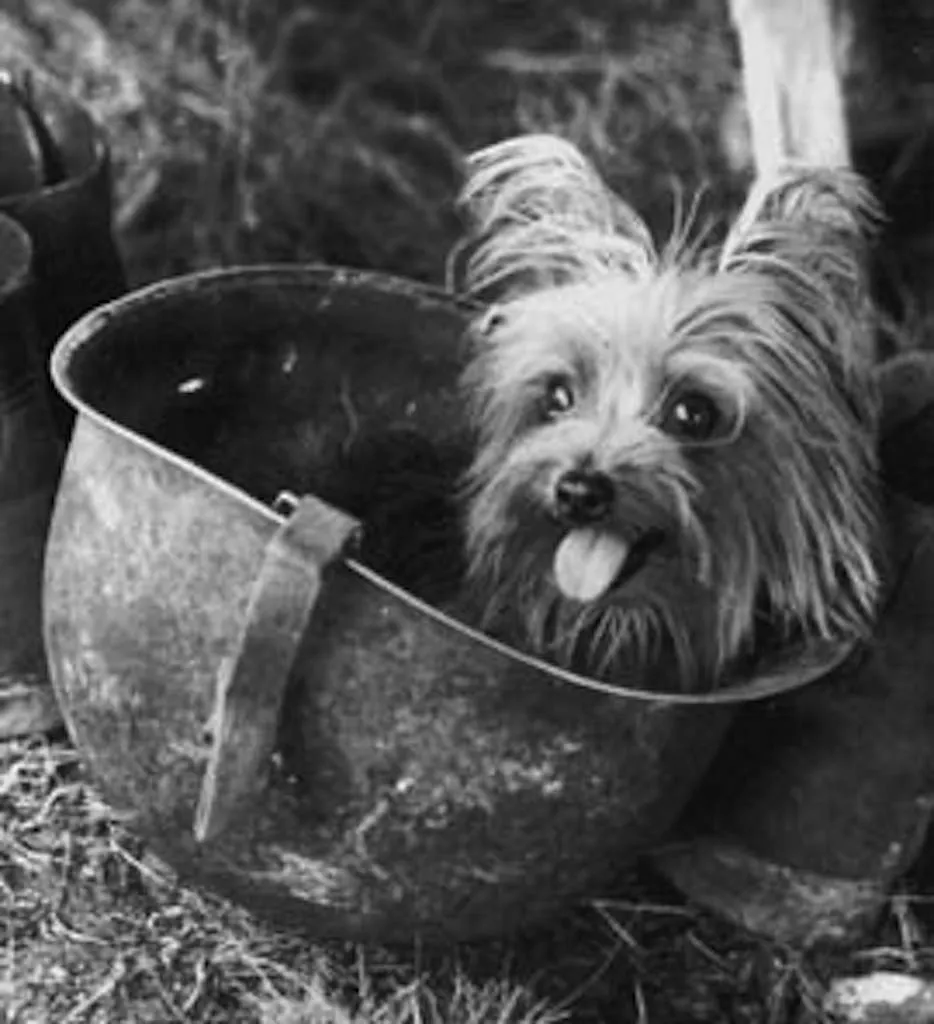
Don’t be fooled by this Yorkshire terrier’s small size. Though tiny, Smoky’s impact on American history was far from it; she served during World War II, as both an entertainer as a soldier, and, on several occasions, was able to save her owner, Bill Wynne‘s, life by alerting him of incoming fire, earning her honors of bravery. Today Smoky’s memory is honored with a statue in Lakewood, Ohio, near the dog’s former home in Cleveland.
8
Sgt. Stubby

Does Sgt. Stubby look familiar? If he does, it might be because you’ve seen his animated face plastered on billboards everywhere, thanks to the 2018 movie inspired by his story, Sgt. Stubby: An American Hero. The patriotic pup served in World War I for 18 months, successfully saving his regiment from several surprise gas attacks and even once capturing a German soldier (by holding him by his pants). Thanks to his heroic efforts, Stubby is the only dog to ever be nominated for rank and subsequently promoted to sergeant.
9
Rags

It’s the ultimate wags to riches tale. Originally just a stray dog roaming Paris with nowhere to go, Rags became a war hero when Private James Donovan of the U.S. 1st Infantry Division took Rags back to the unit and deemed the pup the infantry’s mascot. During the war, Rags played a vital role as a message carrier, running notes between the rear headquarters and the front lines to warn the troops of incoming attacks. His biggest role came during the Meuse-Argonne Campaign, when the dog managed—despite being bombed, gassed, and slightly blinded—to deliver a message that contained vital information, leading to the capture of a fortified French position, the Very-Epinonville Road, and saved countless soldiers’ lives.
10
Bud Nelson
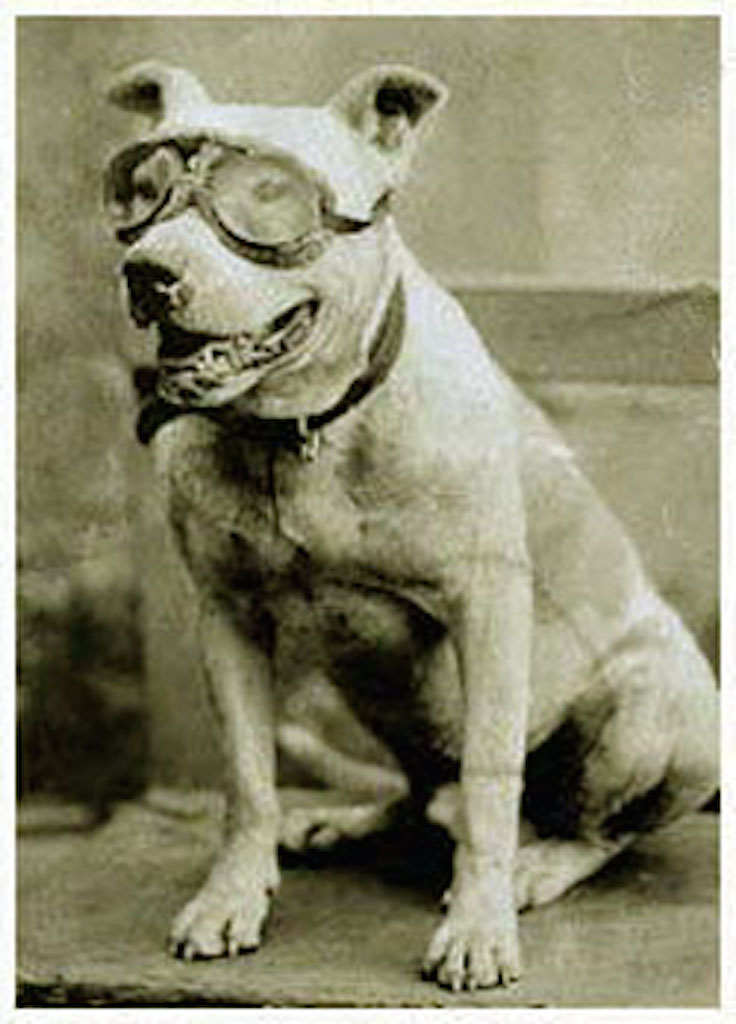
Alongside his human Horatio Nelson Jackson, Bud Nelson became the first dog to cross the United States in an automobile in 1903. And while Bud might look stylish as ever in his goggles, he actually wore them not as a fashion statement, but because the car that he and his owner took had no roof and was constantly spurting out smoke and toxic fumes. While Bud is no longer with us, his goggles remain on display at the Smithsonian Museum of American History.
11
Pal

Though today the illustration of a dog with a circle around its eye immediately makes most people think of Target ads, back in the 1920s such a description would conjure up an image of another dog completely. His name was Pal, but most people at the time knew him better as Petey, or even as “Peter, the dog with the ring around his eye.” This ring around his eye—which, yes, occurred naturally—made Pal/Petey quite famous, and even scored him leading roles in such series as Buster Brown and, of course, Our Gang (later known as The Little Rascals). When Pal died in 1930, his son Pete took over his role as Petey in The Little Rascals, and both pups are remembered fondly as the original circle-eyed canines.
12
Sallie

Sallie Ann Jarrett, or just Sallie for short, was the mascot of the 11th Pennsylvania Infantry during the American Civil War. The dog was presented to the captain of the Infantry, Capt. William R. Terry, while they were training in West Chester, Pennsylvania, and, as it was the gentlemanly thing to do, he decided to keep the dog as the mascot.
What Terry could have never predicted, though, was that the dog would quickly take to army training, even going so far as to join battles and fight alongside her fellow soldiers. And in July 1963, after Sallie became separated from her troops during the first day at Gettysburg, her men found her three days later at their former location, guarding injured soldiers. When the remaining soldiers of the 11th Pennsylvania Infantry erected a monument at Gettysburg in 1890, they were sure to include Sallie at the base, “keeping guard.”
13
Nemo

Before there was Nemo the clownfish, there was Nemo, the hero dog of the Vietnam War. In the summer of 1965, Nemo was sent out with 40 other sentry dogs to South Vietnam in order to assist the U.S. Air Force stationed there and detect any incoming enemy movement. In 1966, the German Shepherd performed his job well when enemies snuck past the perimeter and he and his handler, Airman 1st Class Robert Throneburg, attacked them simultaneously.
Unfortunately, Nemo was hit in the snout during retaliation, and the dog did leave the battle with one less eye. However, he was deemed a hero for saving his handler’s life, and he lived happily as a hero until his death in 1972.
14
Lucca
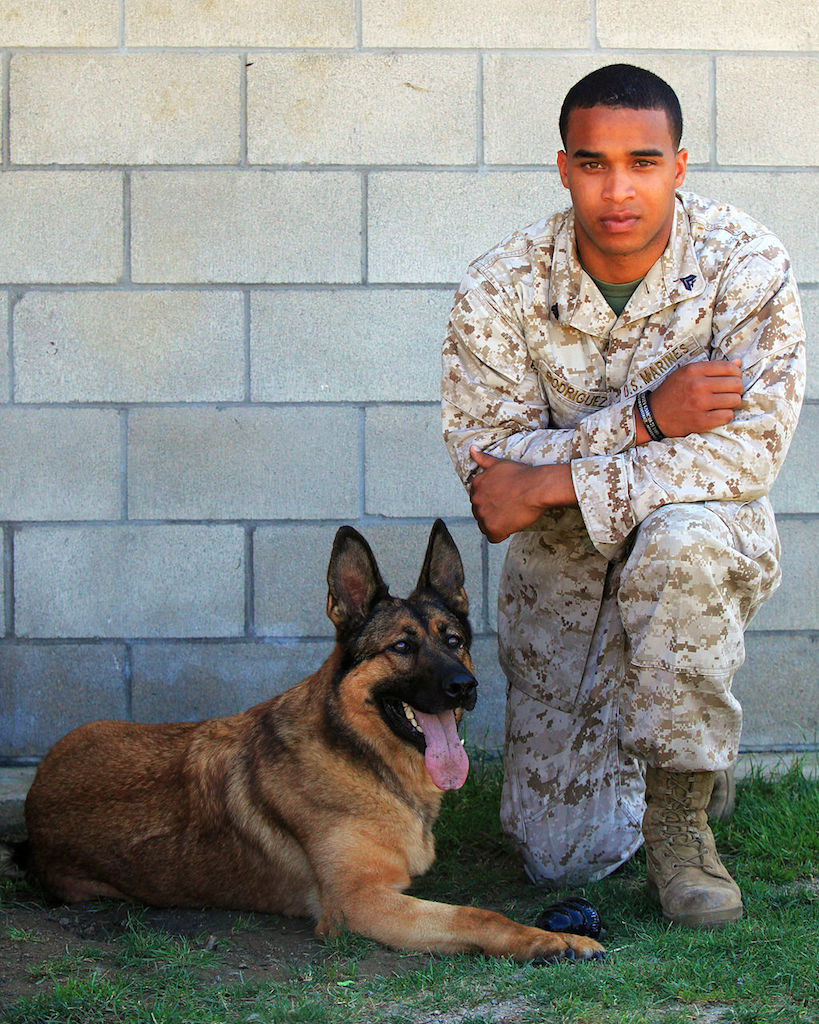
Lucca, a German Sheperd/Belgian Malinois mix, was a service dog trained to detected explosives. During her six-year stint with the Marines, she was sent twice to Iraq and once to Afghanistan, serving in over 400 missions with zero fatalities. In 2012, Lucca was injured by an IED blast, leading the amputation of her left leg and subsequent retirement, but her efforts were acknowledged by a Dickin Medal from the People’s Dispensary for Sick Animals and by an unofficial Purple Heart plaque.
15
Lex

Not only is Lex the military dog a hero, but his story is also a pleasant reminder of the loyalty of canine companions. While deployed in Iraq as part of an explosive detection team for 3rd Reconnaissance Battalion, Lex and his Marine Corps handler Corporal Dustin J. Lee got caught in a rocket attack, leaving Lee dead and Lex severely wounded. However, Lex refused to leave his owner’s side—and it was only when he was physically dragged away that he ever actually did. Because of his unique situation, Lex became the first physically fit military dog to be granted early retirement, and he lived out the rest of his days with his former handler’s family until his death in 2012.
16
Apollo

After news broke about the attacks at the World Trade Center on September 11, 2001, Apollo was the first search-and-rescue dog to arrive at the South Tower alongside his handler Peter Davis. Risking his own life to save the wounded, Apollo dragged victims of the attack out of harm’s way, dodging debris and flames as he worked. The tenacious animal worked 18 hours a day for weeks and, as a thank you for his efforts, received the American Kennel Club Ace award in 2001 and the Dickin Medal in 2002.
17
Sinbad

Sinbad the Sailor was a member of the USCGC Campbell crew, though his enlistment was entirely by accident. The night before the Coast Guard ship set sail from New York, one of the crew’s members—A.A. Roth—tried to gift his girlfriend a new puppy, only to realize that her building didn’t allow dogs. Unsure of what to do with the dog, Rother decided to bring him along—and luckily the rest of the crew quickly took to the mutt, making him their new mascot.
Sinbad earned notoriety during World War II when the cutter was tasked with escorting convoys across the Atlantic. During this time, Campbell got into a tiff with a German submarine that ended up sinking the American ship—and when essential members of the crew were left aboard for the tow ride home, Sinbad was included as a symbol of good luck. Some of the many medals that Sinbad was awarded include the American Defense Service Medical, the American Campaign Medal, and the Asiatic-Pacific Campaign Medical.
18
Owney

In 1888, the United States Post Office wasn’t looking for a mascot, but that’s exactly when they got when a stray dog walked into the post office in Albany, New York, and never left. The dog became known as Owney, and as he became more familiar with the postal workers in Albany, he began riding with them in the wagons and even in the railway mail cars to New York City. Though Albany was always his home, Owney traveled on lines all around the world—and wherever he went, he was given a metal baggage tag to keep on his signature jacket.
19
Buddy

Though Labrador Retrievers are the most common guide dogs today, the first Seeing Eye dog was actually a German shepherd named Buddy. She was trained as the first Seeing Eye dog after a young man named Morris Frank read an article about World War I veterans with guide dogs and reached out to the author, seeking assistance in finding a dog of his own. The author, dog trainer Dorothy Harrison Eustis, agreed to help, and together they trained Buddy as the first guide dog accessible to the average citizen, inspiring the creation of The Seeing Eye in 1929.
20
Clifford
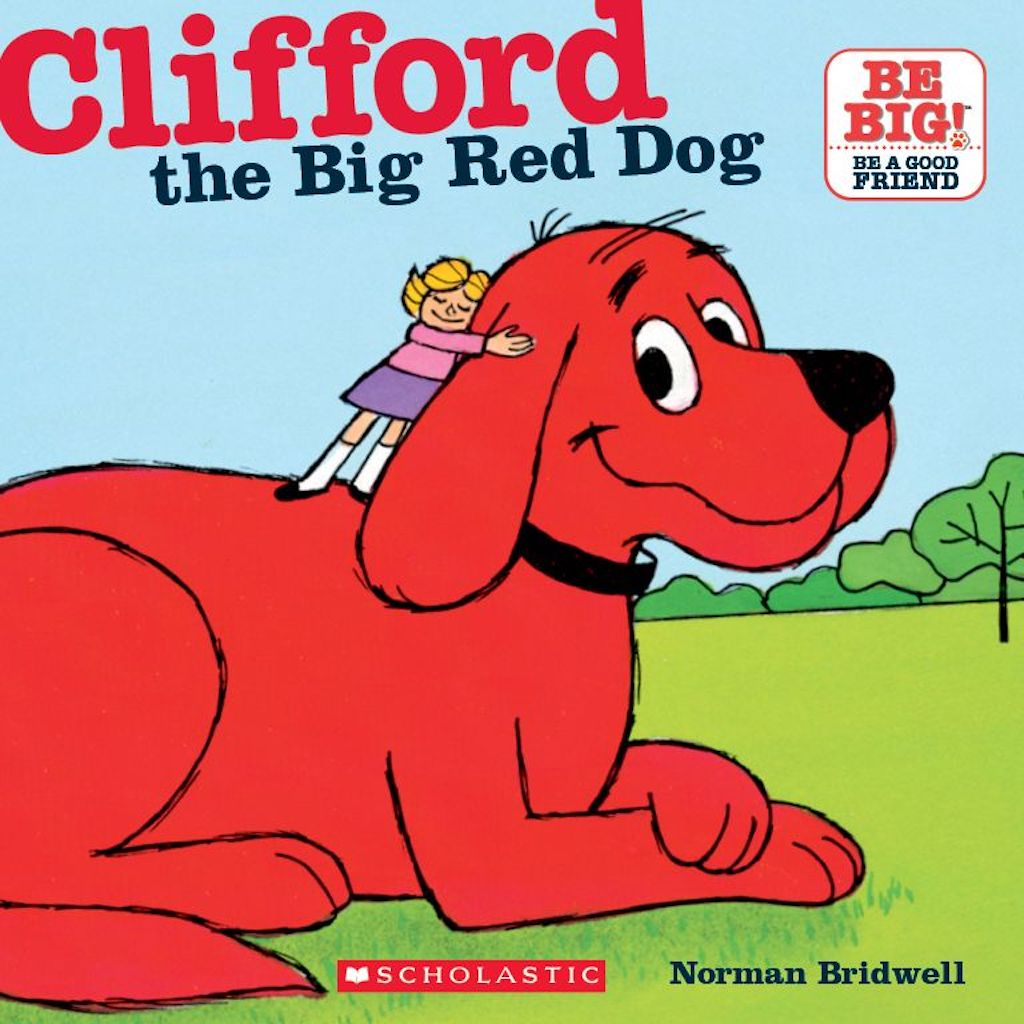
Whether you know Clifford from one of his nearly 90 books, his television series, or his live-action movie, it’s likely that this big red dog has inspired you—or, at the very least, shaped your childhood in some way. With his first book, Clifford the Big Red Dog, appearing on the shelves in 1963, Clifford (and author Norman Bridwell) are credited as establishing Scholastic Books as a top tier publishing house (and Scholastic has honor the big dog’s contributions by making him the mascot of the publishing company). No two ways about it: Big Red is an integral part of American history.
21
Bosco

Most people probably wouldn’t put the fate of their community in the hands—or paws—of a dog, but that’s exactly what Sunol, California, did when they elected Bosco Ramos as the honorary mayor. From 1981 until 1994, Bosco Ramos, a black labrador retriever and Rottweiler mix, served his sunny city well—though he never actually passed any legislation. He did, however, appear on the game show 3rd Degree, and he even brought his small community international notoriety when the Daily Star covered his stint in office, calling Sunol “the wackiest town in the world.”
22
Bretagne

Bretagne was one of the 300 or so search dogs tasked with helping out after the 9/11 attacks, and she was also the last of all the rescue canines to pass away, having recently died in 2016 at the ripe age of 16. The September 11 rescue mission was Bretagne’s first ever, and her usefulness at Ground Zero paved the way for her future success during Hurricanes Katrina and Ivan.
23
Charlie

Charlie Kennedy was the canine son of President John F. Kennedy and a gift from wife Jackie Kennedy while running for president. Though JFK had several dogs, it was Charlie who made the biggest impact on history, seeing as it was the Welsh terrier who sat on the President’s lap while he decided what to do about the missiles in Cuba. Reportedly, Charlie’s presence calmed his owner, and many attribute him being in the room to JFK’s successful handling of the missile crisis.
24
Laddie Boy

However famous the dogs of the White House are now, it’s nothing compared to President Warren G. Harding’s Laddie Boy. According to Smithsonian, the Airedale terrier was reported on in the newspapers frequently, with the dog tagging along to golf outings, cabinet meetings, and fundraising events. As Tom Crouch, a Smithsonian Institution historian, explained: “That dog got a huge amount of attention in the press. There have been famous dogs since, but never anything like this.”
25
Gidget

Gidget—or the Taco Bell chihuahua, as most people know her—is a famous chihuahua known for her role as the mascot of the famous Taco Bell restaurant chain. However, Gidget also has other acting gigs on her resume, having starred in GEICO commercials and even alongside Reese Witherspoon in Legally Blonde 2: Red, White & Blonde.
26
Butch

Having lived to be more than 28 years old, Butch the Beagle is the oldest American dog and second-oldest dog in the world, as authenticated by the Guinness World Records. The only dog to ever live longer than Butch is Bluey, a nearly 30-year-old Australian Cattle Dog from, well, Australia.
27
Cairo

Having gone through the animal equivalent of SEAL training, Belgian Malinois Cairo was sent out alongside SEAL Team Six in 2011 on one of the most important missions in history: the raid to take down Osama bin Laden.While in the field, the dog helped to manage the perimeter of the bin Laden residence, sniffing out bombs and fighting enemy soldiers when needed.
28
Zenit

Any dog worthy of gracing the cover of National Geographic must’ve made quite the impact on American history. And Zenit is no exception, given that the German Shepherd spent most of his life sniffing out IEDs in Afghanistan alongside his handler, Jose Armenta. Unfortunately, Armenta lost both of his legs after a bomb exploded under him in 2011—but in 2012, the former Marine successfully adopted Zenit, enabling the duo to live together back in society.
29
Bobbie

Maybe you’ve heard of lost dogs finding their way home, but you’ve almost definitely never heard of a lost dog traveling more than 2,800 miles in the winter to return to its family. But somehow, that is exactly what Bobbie the Wonder Dog did in 1924—and unsurprisingly, his story became a national sensation. Upon his return, Bobbie was rewarded with everything from jeweled collars to multiple medals, and today you can read all about his journey in Ripley’s Believe It or Not.
30
Sun Yat-Sen
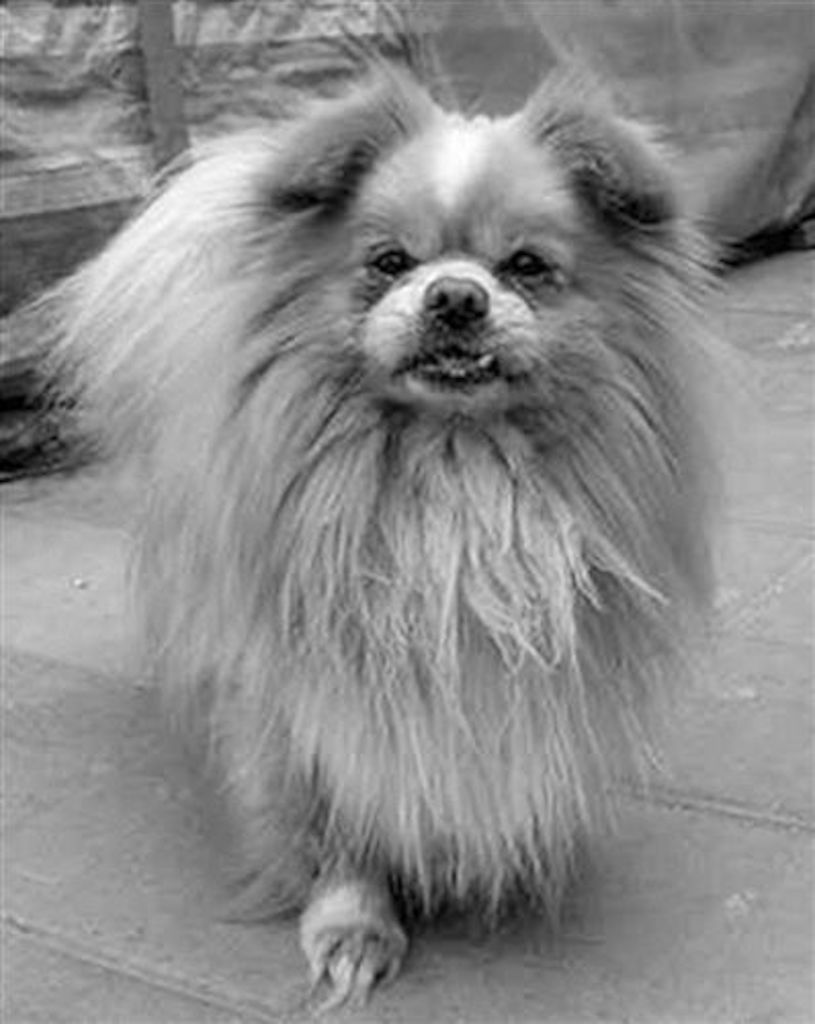
Sun Yat-Sen was one of three dogs to survive the sinking of the Titanic in 1912. According to historians, there were twelve confirmed canines onboard, but only three dogs made it back to shore since their small size allowed them to be snuck onto lifeboats disguised as babies. After the incident, Sun Yat-Sen’s owner Henry Harper was quoted saying that “there seemed to be lots of room, and nobody made any objection [to the dog].”